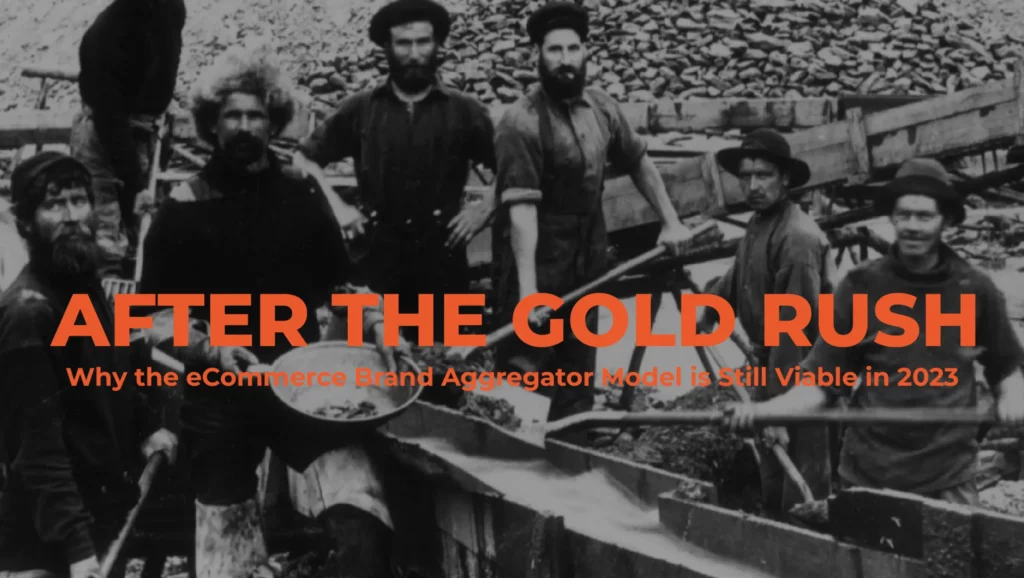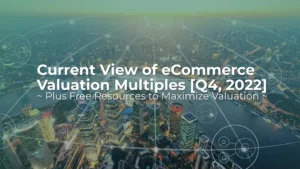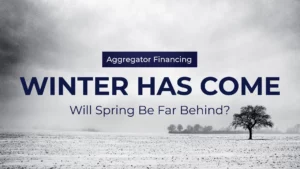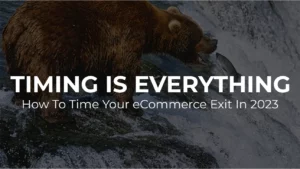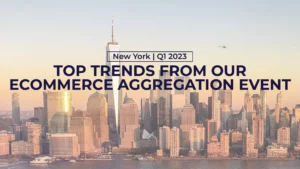Read Time: 5 minutes
In November 2022, we published an article discussing aggregator financing in the context of the eCommerce market that had just experienced the worst quarter of M&A since the crash of 2008.
In light of Q4 2022 forecasts from the US Federal Reserve and leading investment banks, we outlined potential financing options going into 2023 and the strong possibility of industry consolidation or Mergers of Aggregators [MoA].
The market buoyed at the start of 2023, with eCommerce and emerging technologies outpacing legacy retail. However, for an industry fuelled by debt it looked likely that the tough decisions were going to have to be made in Q2 2023 when rates peaked, before a recession/soft-landing [forecasted H2 2023].
Beginning of the End of the Gold Rush
Covid supercharged eCommerce growth in 2019. The investment opportunity quickly snowballed into – what the media dubbed – a modern-day “gold rush” of acquiring brands, with aggregators raising >$16bn in debt to achieve forecasted returns.
Naturally, the distressed sale of Factory14 made headlines [Q1 2022] as it was considered the first falter in a much hyped industry where first movers, Thrasio reached unicorn status quicker than any other company in recent history.
Many eCommerce aggregators responded to the news of Factory14 by shifting focus away from M&A to operations. But, Factory14 wasn’t simply a product of mismanagement nor a lack of economic precedent; there was a wider context that included post-covid landing, war in Ukraine, rising inflation and rate hikes.
Media focus skews toward the negative, but suggesting the aggregation business model as short-sighted or that consolidation is a sign of market implosion is devoid of historical learnings.
P&G have employed the business aggregation model since the 1800s; and waves of consolidation in the US have followed growing markets since the 1890s (see the rise of the conglomerate in the US in the mid 1960s).
In our recent aggregator event in Amsterdam, 57% of aggregators said they were in active negotiations to acquire or be acquired. In a market that effectively launched 150+ well-funded start-ups 3 years ago, consolidation should be expected and signals the beginning of stabilization – after the goldrush.
eCommerce Brand Aggregation | Rise > Peak > Decline > Learnings
Most growth models follow a similar trajectory of “Rise > Peak > Decline > Mature.” Whether you view the current eCommerce brand aggregation sector from a technological or process-driven standpoint or simply from a product’s lifecycle, the “decline” or disappointment phase is inevitable. It’s important to note that the application of learnings from the “decline” phase often determines the key players in the next phase, when the industry stabilizes and begins to mature.
Let’s look at the “Rise > Peak > Decline” phases with regards to learnings going forward. Then, we will ask a legacy firm and a new firm why the model is viable and attractive in 2023.
Phase #1 Rise of the eCommerce Aggregator
Phase one represents the initial breakthrough or –in this case– the launch of the eCommerce aggregator model. Excitement and media attention surround this phase, but the practical application and limitations of the model are not fully understood.
2020/2021 saw multiple hundred million dollar raises to support brand acquisitions and to take advantage of this new opportunity.
Phase #2 Peak Expectations
With great media attention and enthusiasm there is a tendency to inflate expectations and project unrealistic outcomes. In 2021, multiple firms acquired tens of brands at (what we would later learn was) peak valuations, hired aggressively, and began talks of potential IPOs.
Average valuation multiples peaked in the summer of 2021 at 4X-6X SDE for FBA led brands and 6X-10X EBITDA for DTC led brands. And, while the industry understood these valuations to be inflated the hope was our newfound adoption of eCommerce on a global scale –because of COVID– would sustain post-COVID.
Evidence of this “enthusiasm” was seen in our Acquiror Survey Q4 2021 where the majority of aggregators projected to acquire >20 businesses in 2022, with 39% of firms projecting >40 businesses.
Reportedly, a single firm acquired >70 eCommerce brands in 2021; this is unprecedented In the history of M&A.
Phase #3 Decline or Disappointment or Disillusionment
This phase is marked by a decline in enthusiasm as the return on investment does not meet projections, and deficiencies in operations become evident.
Post-COVID hard landing saw a softness enter the market that impacted the contribution margin of assets by as much as 50% [YoY]. According to a leading aggregator, the decrease in profitability rendered assets acquired at a 6X multiple in 2021 as if they had been purchased at a 9X–12X valuation – a significantly higher burden of debt.
Our end-of-year Survey of Acquirors [2022] revealed:
- Deal volumes are down: 90% of firms did less than 10 deals in 2022.
- Valuations are down: 4 out of 5 firms are reporting a >30% decline in valuations, and 37% expect to see further decline in valuations in 2023.
Current valuations [per our eCommerce Valuation Report published Q2 2023]:
- FBA led brands: 2X–4.5X SDE
- DTC led brands: 2X–10X EBITDA
This “Decline” phase is crucial as it separates firms that will pivot, survive and mature from those that will fold. The distressed acquisition of Factory14 signalled the advent of this phase.
Learnings >> Mature Market
Gartner’s Hype Cycle dedicates an entire stage to post-decline learnings called “The Slope of Enlightenment.” This stage is marked by a growing understanding of practical applications, benefits, and potential risks for the model in a particular sector.
In many ways, eCommerce M&A finds itself between phases three [decline] and four [mature] with post-pandemic learnings as the conduit.
Here are some recent learnings from our aggregator event in Amsterdam [Q2 2023]:
- Broad vs. Niche strategies: While 64% of aggregators said they would focus on fewer categories in 2023, our recent poll revealed that 50% of aggregators favoured a blended strategy.
- De Risking through channel and supply chain diversification.
- Restructuring deals to retain the founder. To sustain growth many aggregators are prioritizing new product development. One strategy to achieve this is in-keeping with the PE model of retaining the founder as opposed to migrating the asset in its entirety to inhouse operations, as was standard in 2021.
There is an opportunity for fast followers [new acquirors] that can raise capital, apply the learnings from first movers, and take advantage of these market conditions without the same burden of debt.
Why the eCommerce Brand Aggregator Model is Still Viable in 2023
View from Joseph Falcao, Former CFO at Thrasio.
The eCommerce aggregator model is premised on acquiring assets at single digit EBITDA and creating synergies to justify the value creation. It is basically decentralizing the P&G R&D model to drive global e-commerce Seller Community.
Companies during the pandemic were forced to supersize their organizations and embed strong multiples to acquire eCommerce assets. During the “gold rush,” it may be fair to accept that in-depth cross-functional diligence was not performed well, which was then compounded with supply chain (inventory) issues [H2 2021].
As the market faced the post-covid headwinds, most aggregators intentionally digested the “painful” medicine to reassess (a) growth drivers; (b) supply chain channels; (c) size of the organization; (d) enabling functions like Tech and Finance/accounting; and ( e) divested non-core assets.
Most important, they refined their M&A model and deal with onboarding strategy and synergies. Furthermore, they socialized across the enterprise on how to deal or avoid complexity. They were smart to leverage the economic downturn to strengthen their organizational capability to prepare for the eCommerce Aggregator 2.0.
Despite the media, we are optimistic as to the path forward, which will be fought on three fronts:
- Acquiring new eCommerce assets.
- Getting into new commerce channels (like Shopify, DTC).
- Regaining time by acquiring other “smaller aggregators.”
The 2.0 phase will reset the valuation benchmarks. The top Aggregators want to “win the race” for an IPO. There is an opportunity for more than one going public in this space (like Uber and Lyft).
View From New Aggregator: Go North
Why is the model attractive?
- Less competition: Fewer current buyers, leading to more favourable multiples
- Healthy market & margins: There are over 2,000,000 active sellers on Amazon and over 100,000 have a profit margin >20% and a revenue above $1m USD
- Seamless Brand integration: no need to think about P&C integrations (usually a huge risk and time consuming)/no tax investigations/easy to set up to net suite (ERP systems) etc.,.
What have you learned from first movers?
- Hire experienced operators early – both front and backend.
- Focus on the important few growth levers, to prevent internal distraction, and maximise impact.
- Invest in technology and implement ERP system
- Benchmark against legacy aggregators like P&G and Unilever, not first movers in the sector.
- Don’t separate the M&A department from the rest of the organisation.
- Buy Quality over quantity.
- Be fair to entrepreneurs.
Partner with The Fortia Group
If you are considering selling your eCommerce business in 2023 or 2024, now is a good time to start preparing your business to exit.
Three ways The Fortia Group differs from other firms and secures the best deal:
- We are the only investment bank focused exclusively on the eCommerce sector.
- We offer an Exit Ready programme to prepare your business to go to market, even 1 –3 year out.
- When your business is ready we run a competitive auction with all the relevant buyers including PE firms, family offices and strategics to achieve the best valuation.
Contact us today for an introductory call.
Article Contributors:
Accel Club, Go North, Joseph Falcao.


